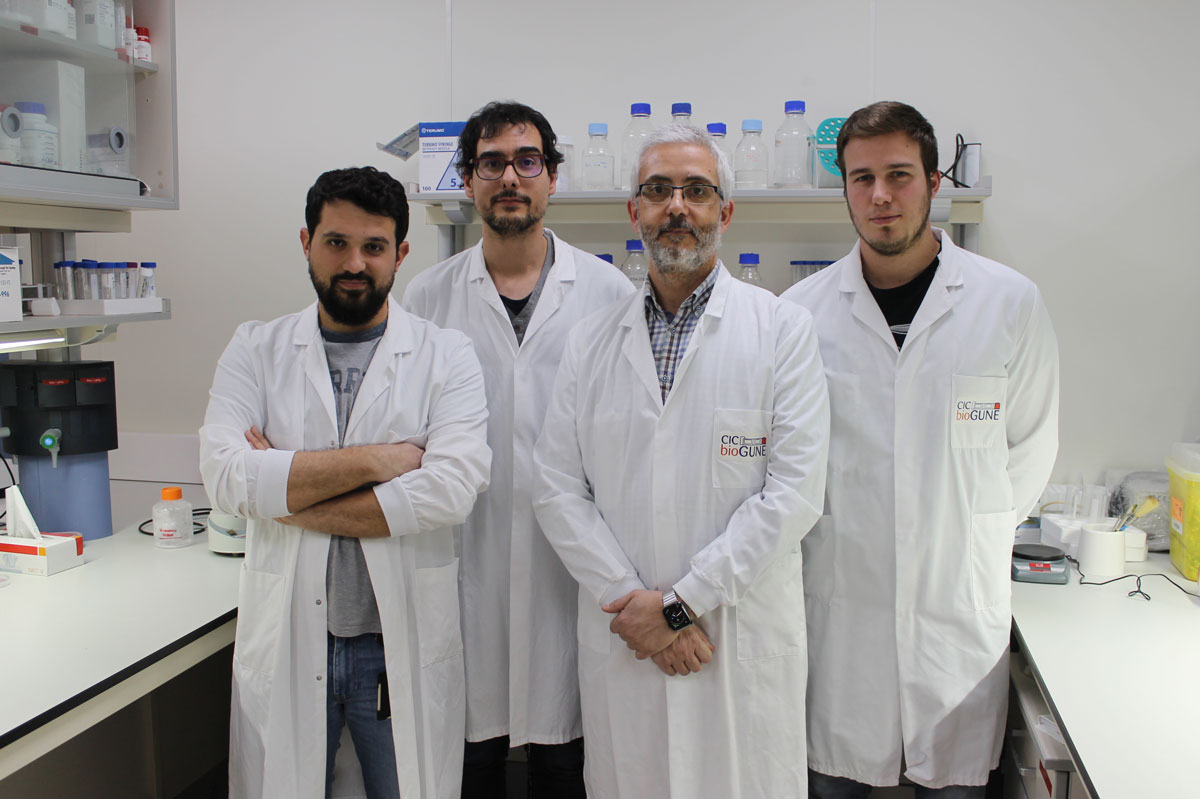
2020/01/17
Researchers discover the resistance mechanisms of dogs to prion diseases
This resistance could be the result of an evolutionary adaptation to carrion consumption.
The research provides clues to determining new therapeutic approaches to combat prion diseases in humans.
(Bilbao, 17 January 2020). Researchers at CIC bioGUNE and IRTA-CReSA have discovered the mechanisms that may govern resistance to prion diseases in dogs. The research, published in the FASEB Journal, one of the world's leading biology journals, confirms the phenomenon of resistance to prions in members of the canidae family, which may be the result of evolutionary adaptation to carrion consumption. The work, which has consisted of mimicking the characteristics of canidae protein in mice, may be key to determining new therapeutic approaches to combat prion diseases in humans.
Prion diseases are caused by the aberrant folding of the cellular prion protein (PrPC) that transforms it into a protein with a pathogenic structure called PrPSc. In mammals, this misfolding produces a group of neurodegenerative diseases which are fatal, since there is no treatment for them.
Prions can be transmitted between different species, the best-known example being bovine spongiform encephalopathy (BSE), commonly referred to as "mad cow disease". The risk of transmission to other species should not be neglected, especially in those species that are closely related to humans. However, there are some species which, despite exposure to prions, do not appear to be susceptible to this type of disease.
Mammals with a very low susceptibility level include pigs, rabbits, horses and dogs, all of whose characteristics have been extensively studied using transgenic models. Canids are the only mammals that, until now, have not had a transgenic model to help explain their unusual resistance to prion diseases.
As Dr. Joaquín Castilla, Ikerbasque researcher at CIC bioGUNE, explains: “In an attempt to explain why canids are the most prion-resistant species studied to date, two transgenic mice were generated to model the situation for members of the canidae family. One of these transgenic mice produces the same prion protein that can be found in a dog, whilst the other presents a mutation that makes it similar to the rest of the susceptible species. Both models were inoculated with different prions to determine their resistance to different types of prion diseases. The results showed that none of these prions produced disease in the mice with normal dog PrP, while the transgenic mice mutated similarly to the rest of the susceptible species were infected with the agent responsible for bovine spongiform encephalopathy (BSE).”
The study reveals that a specific region of dog prion protein appears to be responsible for this resistance to prions. This could be used to further study which mechanisms control prion protein mismatch in mammals, and may provide new insights into a process which, to date, is still a mystery.
“The main difficulty has been to be in a position to state categorically that one of the two generated transgenic mice that modeled canine PrP was completely resistant to prion diseases. To be able to do so, these mice were inoculated with numerous prions to assess their susceptibility, in the hope that they would show resistance to the disease. After waiting the required period of time for the disease to appear, the mice from the resistant group were completely asymptomatic. This result was supported by post-mortem histological studies and the application of a prion detection technique widely used in the field. Both tests showed negative results for the prion disease, thereby clearly demonstrating that canids are resistant to prions,” Joaquín Castilla adds.
The study, which has now been published, has been conducted over the last five years. Studies based on prion inoculations in animal models are always of a lengthy nature due to the incubation times of the disease. In this particular case, when trying to demonstrate resistance to the disease, it was necessary to wait for an even longer period of time, which would completely cover the hypothetical appearance of the disease. Once this period of time had elapsed, the time needed for in vitro studies, including replication to determine reproducibility and detailed biochemical studies, had to be added.
The research has been mainly conducted by two groups: Dr. Castilla’s group in CIC bioGUNE, and Dr. Vidal’s group at IRTA-CReSA. The two doctors have coordinated and co-led the research.
Dr. Vidal's group conducted the in vivo studies, from the inoculation of the transgenic mice through to their clinical follow-up and the post-mortem studies. Some inoculations were performed by Dr. Tomás Mayoral's group at the Central Veterinary Laboratory in Madrid.
Dr. Castilla's group at CIC bioGUNE, as specialists in the in vitro propagation of prions, conducted the studies to confirm resistance to prion disease, and also co-coordinated and led all the research together with Dr. Vidal's group.
The generation of the transgenic lines was the work of Dr. Pintado (National Centre of Biotechnology of Madrid) and Dr. Sánchez-Martín (University of Salamanca). Dr. Mathiason, from the University of Colorado, contributed some of the prions that were inoculated into the experimental models.
About CIC bioGUNE
The Centre for Cooperative Research in Biosciences (CIC bioGUNE), located in the Bizkaia Technology Park, is a biomedical research organisation conducting cutting-edge research at the interface between structural, molecular and cell biology, with a particular focus on generating knowledge on the molecular bases of disease, for use in the development of new diagnostic methods and advanced therapies. CIC bioGUNE has been accredited as a “Severo Ochoa Centre of Excellence”, the highest level of recognition for centres of excellence in Spain. CIC bioGUNE is a member of the Basque Research and Technology Alliance (BRTA), a public consortium formed in collaboration between the Basque Government, the SPRI Group, the Provincial Governments and the Cooperative Research Centres and Technology Centres of the Basque Science, Technology and Innovation Network. The aim of the BRTA is to ensure a "dynamic of cooperation" which enables the future technological and industrial challenges of the Basque Country to be met and its international standing and impact improved.
See a large version of the first picture





